What We’re Reading: August 31
 This week’s edition is guest edited by Arif Ashraf, a PhD student at Iwate University, Japan and Graduate Student Ambassador of ASPB. His research interest is understanding the hormonal interplay in primary root development of Arabidopsis thaliana. He blogs about plant science (http://www.aribidopsis.com/). Arif is available in twitter (@aribidopsis) and Google plus (+Arif).
This week’s edition is guest edited by Arif Ashraf, a PhD student at Iwate University, Japan and Graduate Student Ambassador of ASPB. His research interest is understanding the hormonal interplay in primary root development of Arabidopsis thaliana. He blogs about plant science (http://www.aribidopsis.com/). Arif is available in twitter (@aribidopsis) and Google plus (+Arif).
Photosynthesis and circadian rhythms regulate the buoyancy of marimo lake balls
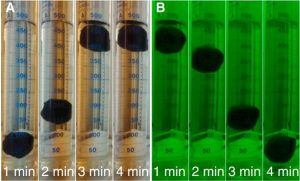 Marimo are aggregations of the filamentous green macroalga Aegagropila linnaei. They grow in lake beds in Japan, Iceland and Ukraine and are can rise to the lake surface after becoming buoyant. In this paper, Cano-Ramirez et al. showed that this movement is the product of the formation of air bubbles by photosynthesis. Given that photosynthesis is controlled by the light-dark cycles, the authors suggested and demonstrated that the floatability of marimo is controlled by the circadian rhythm in response to light. (Summary by Aime Jaskolowski) Curr. Biol. 10.1016/j.cub.2018.07.027
Marimo are aggregations of the filamentous green macroalga Aegagropila linnaei. They grow in lake beds in Japan, Iceland and Ukraine and are can rise to the lake surface after becoming buoyant. In this paper, Cano-Ramirez et al. showed that this movement is the product of the formation of air bubbles by photosynthesis. Given that photosynthesis is controlled by the light-dark cycles, the authors suggested and demonstrated that the floatability of marimo is controlled by the circadian rhythm in response to light. (Summary by Aime Jaskolowski) Curr. Biol. 10.1016/j.cub.2018.07.027
A reductase of green leaf volatiles that affects indirect plant defences
 Green leaf volatiles (GLVs) are a set of six-carbon volatile molecules that are produced in response to wounding and herbivore activity and contribute to plant defences including indirect defences. As yet, the pathways involved in production and removal of GLVs are largely not known. Tanaka et al. identified an enzyme involved in this process, CINNAMALDEHYDE AND HEXENAL REDUCTASE (CHR). Because the Col-0 ecotype of Arabidopsis thaliana has a mutation in a gene (HPL) affecting a biosynthetic step upstream of the six-carbon GLVs, the authors made use of the No-0 ecotype carrying a functional HPL gene to characterize the effects of loss-of-function of CHR. As compared to CHR HPL plants, chr HPL plants have deficiencies in the reduction of six-carbon aldehydes to six-carbon alcohols and a decrease in their indirect defences by lowering their attractiveness to parasitic wasps. (Summary by Mary Williams) Plant Physiol. 10.1104/pp.18.00632
Green leaf volatiles (GLVs) are a set of six-carbon volatile molecules that are produced in response to wounding and herbivore activity and contribute to plant defences including indirect defences. As yet, the pathways involved in production and removal of GLVs are largely not known. Tanaka et al. identified an enzyme involved in this process, CINNAMALDEHYDE AND HEXENAL REDUCTASE (CHR). Because the Col-0 ecotype of Arabidopsis thaliana has a mutation in a gene (HPL) affecting a biosynthetic step upstream of the six-carbon GLVs, the authors made use of the No-0 ecotype carrying a functional HPL gene to characterize the effects of loss-of-function of CHR. As compared to CHR HPL plants, chr HPL plants have deficiencies in the reduction of six-carbon aldehydes to six-carbon alcohols and a decrease in their indirect defences by lowering their attractiveness to parasitic wasps. (Summary by Mary Williams) Plant Physiol. 10.1104/pp.18.00632
The mechanism of SO2-induced stomatal closure differs from O3 and CO2 responses and is mediated by non-apoptotic cell death in guard cells ($)
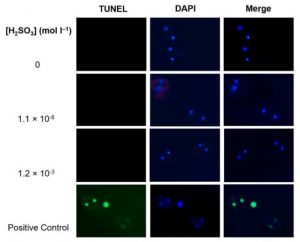 Stomata opening and closing are regulated by guard cells. Airborne pollutants such as ozone, sulfur dioxide, and nitrogen dioxide cause stomatal closure. In this study, Lia Ooi et al. tried to understand the molecular mechanism of SO2-induced stomatal closure. SO2 is found in three forms in aqueous solution (H2CO3, HSO3–, SO32-) and the authors showed that H2SO3 is responsible for the stomata closure. Interestingly, SO2 induces stomata closure using a different molecular mechanism than that used by O3 and CO2. The authors demonstrated that SO2-induced stomatal closure correlates with non-apoptotic cell death in guard cells. This study reveals a unique stress avoidance response of stomata against SO2 gas. (Summary by Arif Ashraf) Plant Cell Environ. 10.1111/pce.13406
Stomata opening and closing are regulated by guard cells. Airborne pollutants such as ozone, sulfur dioxide, and nitrogen dioxide cause stomatal closure. In this study, Lia Ooi et al. tried to understand the molecular mechanism of SO2-induced stomatal closure. SO2 is found in three forms in aqueous solution (H2CO3, HSO3–, SO32-) and the authors showed that H2SO3 is responsible for the stomata closure. Interestingly, SO2 induces stomata closure using a different molecular mechanism than that used by O3 and CO2. The authors demonstrated that SO2-induced stomatal closure correlates with non-apoptotic cell death in guard cells. This study reveals a unique stress avoidance response of stomata against SO2 gas. (Summary by Arif Ashraf) Plant Cell Environ. 10.1111/pce.13406
Construction of a functional Casparian strip in non-endodermal lineages is orchestrated by two parallel signaling systems ($)
 The Casparian strip in the endodermis acts a barrier to allow the selective absorption of water and nutrients. Because of its cell-specific presence, the Casparian strip is considered a marker for functional endodermis. The cellular identity of endodermis is controlled by two transcription factors, SHR (SHORTROOT) and SCR (SCARECROW). In absence of SHR, the endodermal cell layer is lost. Additionally, peptides CIF1 (Casparian strip Integrity Factor) and CIF2 bind to the SGN3 (SCHENGEN 3) receptor and promote Casparian strip formation. In this paper, authors investigated the minimal requirement for creating a Casparian strip in a non-endodermal cell layer. Their results showed that SHR initiated an up-stream signaling cascade for Casparian strip formation and its three major targets are SGN3, SCR and MYB36. SGN1 and SGN3 regulate enzymes required for building the Casparian strip, SCR directs the subcellular localization of Casparian strip and MYB36 regulates the gene necessary for lignin polymerization. Altogether, this work suggests that combination of peptides CIFs and SHR-mediated network is sufficient to form functional Casparian strip in non-endodermal cells. (Summary by Arif Ashraf) Curr. Biol. 10.1016/j.cub.2018.07.028
The Casparian strip in the endodermis acts a barrier to allow the selective absorption of water and nutrients. Because of its cell-specific presence, the Casparian strip is considered a marker for functional endodermis. The cellular identity of endodermis is controlled by two transcription factors, SHR (SHORTROOT) and SCR (SCARECROW). In absence of SHR, the endodermal cell layer is lost. Additionally, peptides CIF1 (Casparian strip Integrity Factor) and CIF2 bind to the SGN3 (SCHENGEN 3) receptor and promote Casparian strip formation. In this paper, authors investigated the minimal requirement for creating a Casparian strip in a non-endodermal cell layer. Their results showed that SHR initiated an up-stream signaling cascade for Casparian strip formation and its three major targets are SGN3, SCR and MYB36. SGN1 and SGN3 regulate enzymes required for building the Casparian strip, SCR directs the subcellular localization of Casparian strip and MYB36 regulates the gene necessary for lignin polymerization. Altogether, this work suggests that combination of peptides CIFs and SHR-mediated network is sufficient to form functional Casparian strip in non-endodermal cells. (Summary by Arif Ashraf) Curr. Biol. 10.1016/j.cub.2018.07.028
Rapid and dynamic alternative splicing impacts the Arabidopsis cold response transcriptome ($)
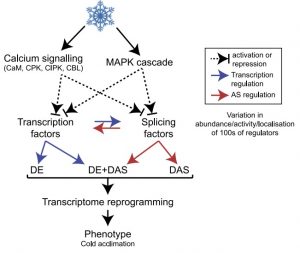 Plants experience abiotic stresses, such as alteration of temperature, and their responses have been studied through transcriptomics and proteomics approaches. X et al have studied how low temperature stress affects the transcriptome through alternative splicing. The author showed that a few hours after cold stress, rapid alternative splicing occurs. Interestingly, some of the early alternatively-spliced genes are cold-responsive transcription factors and splicing factors/RNA binding proteins (SF/RBP). From this early alternative spliced set of genes, the authors identified four genes previously known to be involved in freezing tolerance and acclimation. One of these encodes a splicing factor, and mutant plants show a reduced ability to tolerate freezing. These studies demonstrate that alternative splicing contributes to freezing tolerance. (Summary by Arif Ashraf) Plant Cell 10.1105/tpc.18.00177
Plants experience abiotic stresses, such as alteration of temperature, and their responses have been studied through transcriptomics and proteomics approaches. X et al have studied how low temperature stress affects the transcriptome through alternative splicing. The author showed that a few hours after cold stress, rapid alternative splicing occurs. Interestingly, some of the early alternatively-spliced genes are cold-responsive transcription factors and splicing factors/RNA binding proteins (SF/RBP). From this early alternative spliced set of genes, the authors identified four genes previously known to be involved in freezing tolerance and acclimation. One of these encodes a splicing factor, and mutant plants show a reduced ability to tolerate freezing. These studies demonstrate that alternative splicing contributes to freezing tolerance. (Summary by Arif Ashraf) Plant Cell 10.1105/tpc.18.00177
PORCUPINE regulates development in response to temperature through alternative splicing ($)
 In this study, the authors performed strand-specific RNA sequencing of wild-type seedlings at 16°C, 23°C, and 27°C. They have found one candidate gene, a small nuclear robinucleoprotein family protein which contains a Like-Sm (LSM) domain. They named it as PORCUPINE (PCP) due to its “spiky” phenotype. As a temperature-specific mutant, pcp-1 shows dramatic developmental defects only at 16°C. Additionally, they found that WUSCHEL (WUS) expression was increased and CLAVAT3 (CLV3) expression was decreased at the same time in pcp-1 at 16°C. One may predict that as a splicing factor, PCP may alternatively splice developmentally important genes WUS and CLV3. In fact, it was not the reason and it was predicted that PCP regulates shoot apical meristem development through WUS and CLV3 in an unknown pathway. Although this article left us without mechanistic explanation, it has provided an amazing ground for future research to explore how a temperature-specific splicing factor regulates the array of genes important for plant development. (Summary by Arif Ashraf) Nature Plants: 10.1038/s41477-018-0176-z
In this study, the authors performed strand-specific RNA sequencing of wild-type seedlings at 16°C, 23°C, and 27°C. They have found one candidate gene, a small nuclear robinucleoprotein family protein which contains a Like-Sm (LSM) domain. They named it as PORCUPINE (PCP) due to its “spiky” phenotype. As a temperature-specific mutant, pcp-1 shows dramatic developmental defects only at 16°C. Additionally, they found that WUSCHEL (WUS) expression was increased and CLAVAT3 (CLV3) expression was decreased at the same time in pcp-1 at 16°C. One may predict that as a splicing factor, PCP may alternatively splice developmentally important genes WUS and CLV3. In fact, it was not the reason and it was predicted that PCP regulates shoot apical meristem development through WUS and CLV3 in an unknown pathway. Although this article left us without mechanistic explanation, it has provided an amazing ground for future research to explore how a temperature-specific splicing factor regulates the array of genes important for plant development. (Summary by Arif Ashraf) Nature Plants: 10.1038/s41477-018-0176-z
The inhibitor Endosidin 4 targets SEC7 domain-type ARF GTPase exchange factors and interferes with subcellular trafficking ($)
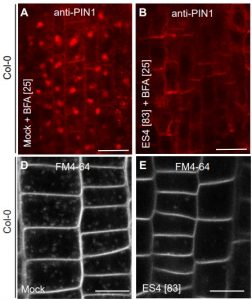 Subcellular trafficking helps determine the development of the plant through for instance the regulation of polar localization of auxin transporter PIN-FORMED (PIN) proteins. PIN trafficking or recycling is maintained by GNOM, a BFA-sensitive ARF GEF (ADP-ribosylation factor guanine nucleotide exchange factor). Much of what we know about ARF-GEFs comes from studies using the fungal inhibitor Brefeldin A (BFA). BFA inhibits most of the ARF GEFs, except GNL1 and BIG3. In this work, the authors used a chemical genetics approach and identified Endosidin 4 (ES4) as an inhibitor of ARF/ARF GEF-dependent pathway. ES4 interrupts endosomal protein trafficking by targeting SEC7-domain containing ARF GEFs. ES4 will help to dissect unknown functional roles of ARF GEFs for plant development. (See also this companion paper describing the characterization of another ARF GEF inhibitor, Secdin). (Summary by Arif Ashraf) Plant Cell: 10.1105/tpc.18.00127
Subcellular trafficking helps determine the development of the plant through for instance the regulation of polar localization of auxin transporter PIN-FORMED (PIN) proteins. PIN trafficking or recycling is maintained by GNOM, a BFA-sensitive ARF GEF (ADP-ribosylation factor guanine nucleotide exchange factor). Much of what we know about ARF-GEFs comes from studies using the fungal inhibitor Brefeldin A (BFA). BFA inhibits most of the ARF GEFs, except GNL1 and BIG3. In this work, the authors used a chemical genetics approach and identified Endosidin 4 (ES4) as an inhibitor of ARF/ARF GEF-dependent pathway. ES4 interrupts endosomal protein trafficking by targeting SEC7-domain containing ARF GEFs. ES4 will help to dissect unknown functional roles of ARF GEFs for plant development. (See also this companion paper describing the characterization of another ARF GEF inhibitor, Secdin). (Summary by Arif Ashraf) Plant Cell: 10.1105/tpc.18.00127
Nonselective chemical inhibition of Sec7 domain-containing ARF-GEFs in Arabidopsis ($)
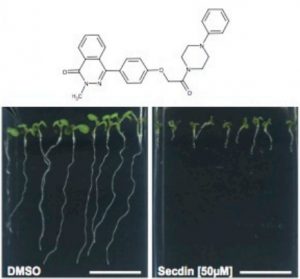 ARF GEFs (ADP-ribosylation factor guanine nucleotide exchange factors) play a major role in the intracellular trafficking and eventually regulate developmental cues. As plants contain multiple ARF GEF with very similar sequences, chemical genetics approaches are more appropriate to uncover their function compared to classic genetic strategies. The fungal toxin Brefeldin A (BFA) targets the SEC7 domain of ARF-GEFs but does not inhibit all of them. In this study, the authors identified a novel inhibitor, Secdin, which inhibits both BFA-sensitive and BFA-insensitive ARF-GEFs. Interestingly, this inhibition is not SEC7 domain-mediated. As a result, Secdin can be used to understand the roles of these BFA-insensitive ARF GEFs. (See also this companion paper describing the characterization of another ARF GEF inhibitor, Endosidin). (Summary by Arif Ashraf) Plant Cell: 10.1105/tpc.18.00145
ARF GEFs (ADP-ribosylation factor guanine nucleotide exchange factors) play a major role in the intracellular trafficking and eventually regulate developmental cues. As plants contain multiple ARF GEF with very similar sequences, chemical genetics approaches are more appropriate to uncover their function compared to classic genetic strategies. The fungal toxin Brefeldin A (BFA) targets the SEC7 domain of ARF-GEFs but does not inhibit all of them. In this study, the authors identified a novel inhibitor, Secdin, which inhibits both BFA-sensitive and BFA-insensitive ARF-GEFs. Interestingly, this inhibition is not SEC7 domain-mediated. As a result, Secdin can be used to understand the roles of these BFA-insensitive ARF GEFs. (See also this companion paper describing the characterization of another ARF GEF inhibitor, Endosidin). (Summary by Arif Ashraf) Plant Cell: 10.1105/tpc.18.00145



